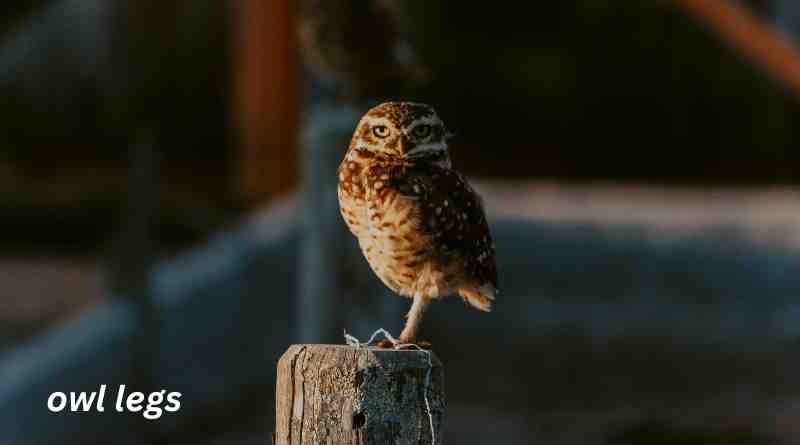Owls have captivated human fascination for centuries with their enigmatic presence and silent flight. However, one of the most intriguing aspects of these nocturnal predators is their legs, which remain largely hidden beneath their feathers. This article delves into the mystery of owl legs, exploring their anatomy, function, and unique adaptations that make owls such efficient hunters.
Anatomy of Owl Legs
Owls, like all birds, have a skeletal structure specifically adapted for flight and hunting. However, the legs of owls possess unique characteristics that set them apart from other avian species. Owl legs are remarkably long and powerful, although this is not immediately apparent due to the dense plumage that typically covers them.
Skeletal Structure
The skeletal structure of an owl’s legs is both robust and flexible, designed to support their predatory lifestyle. The leg bones, particularly the femur, tibia, and tarsus, are elongated and sturdy. These bones provide the necessary leverage and strength for capturing and handling prey. Additionally, owls have a specialized joint structure that allows them to swivel their talons with great precision, a crucial adaptation for securing struggling prey.
Musculature
Beneath the feathers, owl legs are equipped with strong muscles that facilitate powerful and swift movements. The primary muscles involved include the flexors and extensors, which control the contraction and extension of the toes and talons. This muscular arrangement is essential for the owl’s ability to grip and immobilize prey with extraordinary force. The combination of long bones and powerful muscles enables owls to exert a crushing grip, often lethal to their prey.
Adaptations for Hunting
The legs of owls are not just structurally fascinating but are also highly adapted for their hunting lifestyle. These adaptations enhance their ability to silently stalk and efficiently capture prey, contributing to their success as nocturnal hunters.
Silent Flight and Stealth
One of the most remarkable adaptations of owl legs is their role in silent flight. The feathers covering the legs, known as “tarsi,” are soft and downy, which helps in muffling the sound of their movements. This silent approach is critical for surprising prey and is a unique trait among raptors. The legs’ positioning also aids in maintaining balance and stability during flight, ensuring that the owl can remain stealthy even when making swift aerial maneuvers.
Talon Design
Owls are equipped with sharp, curved talons that are perfectly designed for capturing and killing prey. The talons are extremely sharp and can inflict fatal wounds on their victims. An interesting feature of owl talons is the zygodactyl arrangement, where two toes point forward and two backward. This configuration provides a more effective grip compared to the anisodactyl arrangement seen in many other birds. The ability to rotate one of the backward-facing toes forward adds to the versatility of their grip, making it easier to handle prey of various sizes.
Behavioral Insights
Understanding the behavior associated with owl legs provides deeper insights into their predatory strategies and overall survival mechanisms. From perching to pouncing, owl legs play a crucial role in various aspects of their daily lives.
Perching and Roosting
Owls often perch on high branches or other vantage points to survey their surroundings. The structure of their legs and feet allows them to grip securely onto perches, even in windy conditions. The tendons in their legs have a unique locking mechanism that prevents muscle fatigue, enabling owls to maintain a firm grip for extended periods. This adaptation is particularly useful during the day when owls are roosting and need to remain hidden and secure from potential threats.
Hunting Techniques
When hunting, owls rely heavily on their legs for launching and capturing prey. Upon spotting potential prey, an owl will use its powerful legs to propel itself from its perch in a swift, silent dive. The legs and talons are then extended to snatch the prey with remarkable precision. This technique is often executed in complete darkness, relying on the owl’s acute sense of hearing and exceptional night vision to locate and capture its target.
Ecological and Evolutionary Significance
The evolution of owl legs is a testament to their specialized role within their ecosystems. These adaptations not only enhance their hunting efficiency but also reflect the evolutionary pressures that have shaped their development over millions of years.
Evolutionary Adaptations
The distinct features of owl legs have evolved over time to meet the specific demands of their ecological niches. Fossil records indicate that early owls had similar leg structures, suggesting that these adaptations have been successful for a considerable period. The zygodactyl toe arrangement, powerful musculature, and silent flight capabilities are all results of evolutionary refinement, providing owls with a competitive edge in their environments.
Ecological Role
Owls occupy a vital role in maintaining the balance of ecosystems. As apex predators, they help control the populations of small mammals, birds, and insects. Their legs and talons are instrumental in this role, allowing them to capture a wide variety of prey efficiently. By regulating prey populations, owls contribute to the health of their habitats, preventing overpopulation and the subsequent depletion of resources.
Human Fascination and Cultural Significance
Owls have long held a place in human culture and mythology, often symbolizing wisdom, mystery, and even omens. Their legs, though less often highlighted, contribute to this fascination by adding to their overall mystique and prowess as hunters.
Cultural Symbolism
In various cultures, the owl’s legs have been symbolically associated with strength and dexterity. For instance, in some Native American traditions, owls are revered as powerful protectors and symbols of courage, with their legs representing their ability to navigate both the physical and spiritual realms. In mythology, the owl’s silent flight and powerful legs have often been linked to stealth and unseen knowledge, further enhancing their aura of mystery.
Modern Interest and Research
Today, the fascination with owls extends into scientific research, where their legs are studied for insights into biomechanics and evolutionary biology. Researchers examine the structure and function of owl legs to understand better how these birds have adapted to their environments. This research not only adds to our knowledge of owls but also informs broader studies on avian evolution and adaptation.
Conservation and Protection
Understanding the importance of owl legs in their hunting and survival highlights the need for their conservation. Owls face various threats, including habitat loss, pollution, and climate change, which can impact their ability to hunt and survive.
Conservation Efforts
Efforts to protect owl populations often focus on preserving their natural habitats and ensuring a stable food supply. Protecting large tracts of forest and open land is crucial for providing owls with suitable perching and hunting grounds. Additionally, conservation programs aim to mitigate the impacts of pesticide use, which can reduce prey availability and affect owl health.
Rehabilitation and Research
Injured owls, particularly those with damaged legs, are often rehabilitated by wildlife rescue organizations. These efforts are vital for the survival of individual owls and for maintaining healthy populations. Rehabilitation includes medical treatment, physical therapy, and sometimes surgery to repair damaged bones and muscles. Research on owl leg injuries also contributes to improving conservation strategies, providing valuable data on the types of threats owls face in the wild.
Conclusion
Owl legs, with their unique anatomy and specialized adaptations, play a crucial role in the life of these enigmatic birds. From silent flight to powerful hunting capabilities, the legs of owls are marvels of evolutionary design. Understanding the intricacies of owl legs not only deepens our appreciation for these nocturnal predators but also underscores the importance of their conservation. As we continue to study and protect owls, their legs remain a symbol of their remarkable abilities and enduring mystery.
Read also: check









Leave a Reply